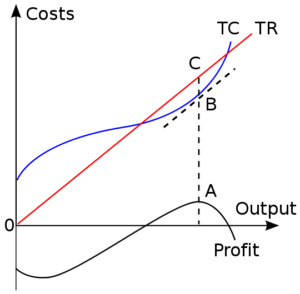 The profit curve of a firm is the total revenue (TR) curve less the total cost (TC) curve. these curves display the fluctuations of cost or revenue (Vertical Axis) at a given levels of output (increasing along Horizontal Axis).
The profit curve of a firm is the total revenue (TR) curve less the total cost (TC) curve. these curves display the fluctuations of cost or revenue (Vertical Axis) at a given levels of output (increasing along Horizontal Axis).
Along the section of the curve where Total Cost is below Total Revenue, the point at which the 1st derivative of the Total Cost (TC) Curve is parallel (B) with the Total Revenue curve represents the level of output where Profit is maximized (A).
So now that you know this, what are the variables that you, the Business Owner, can address that impact “The Profit Curve”?
There are Six areas of your Business that you can address by defining Strategies, implementing Actions to increase Profits. Over the next few weeks, we will look in details to all six.
As your ultimate goal in your Business is to increase profits let’s look at the Six areas of your Business to address for profits are:
- Personal Profitability
- People Profitability
- Customer Profitability
- Sales / Marketing Profitability
- Product / Service Profitability
- Market Profitability
Product / Service Profitability:
As we stated at the outset of this session, every product / service yields a specific profit of a specific amount. When you offer more than one product / service, each will have its own profit margin. One of the most important things you can do is to determine the return on the investment you have put into each of your product / services.
Marathon and Associates, a niche consulting firm, receives enormous fees from Fortune 1000 companies to determine the exact cost of each of their products / services. This enables their clients to make product / service offering decisions based on the profitability of each product rather than simply relying on gross revenue figures. In today’s highly competitive business climate, such an approach is critical in ensuring their overall profitability and even their survival. This is no less true of your own business. Eliminating just one losing product / service can make the difference between robust growth and mediocre performance or even the demise of your business.
Examine your own product / service mix. In addition to the normal “cost of goods,” you must include all expenses incurred in delivering the finished product / service to the consumer, including Research & Development, Promotion, associated Sales and Marketing costs, Installation, Customer Service, Product Service, Returns, proportionate share of General and Administrative costs and so on.
Again, be sure to include the cost of your own time; apply your hourly rate to the amount of time you invest in the development, design, creation/manufacturing, sale and servicing of the product / service.
Many individuals and businesses lump all their expenses together and then guess at how much is attributable to each product / service. Your job is to break your costs down so accurately that you know within a few dollars exactly how much you net from the sale of each product / service.
When you have completed your costing analysis, simply deduct the actual cost of developing, selling and delivering each product / service from the price to determine its profitability. Which product / service yield the highest return? The lowest? Do any actually lose money?
As you continue to grow your business by driving sales, remember that the critical measure of success in any business is profits. Develop the habit of regularly examining the profitability of your Product / Service.
For more information on HOW you can contact one of our Business Coaches at: 1.610.768.7774.
